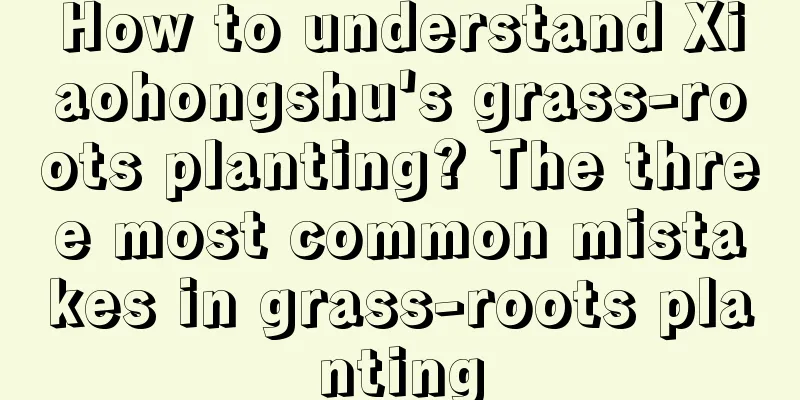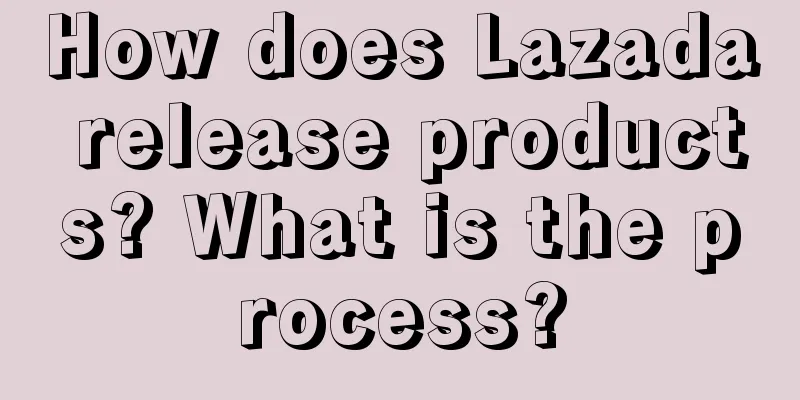How to understand Xiaohongshu's grass-roots planting? The three most common mistakes in grass-roots planting

I want to promote something on Xiaohongshu, what should I do specifically? What is grass planting? Why do we need to plant grass? How to plant grass? Almost no one in the market can explain these concepts clearly, but it seems that everyone can talk about them. In fact, there are also conceptual problems with words such as brand, logo, operation, market, marketing, and product, but "种草" is more mysterious than these words, because these words have definitions in the Xinhua Dictionary, but "种草" has no explanation in the Xinhua Dictionary, which is the culprit of the conceptual confusion. Figure 1: Search results for the online Chinese dictionary “种草” Is the term "planting grass" just appearing? It is a new term. In my opinion, it is just the opposite. This term has existed since the birth of mankind. At that time, it was not called "planting grass" but "conflict", a desire to pursue greed, anger, ignorance, truth, goodness and beauty. Imagine a scene where a Homo sapiens accidentally cooked a barbecue over fire. He and his companions described the huge difference between cooked meat and raw meat. His companions were inspired by his description and cooked a barbecue right away, and found it was really delicious. At this point, barbecue became popular on the grassland. From this example, we can see that planting grass is contagious and can be reposted and shared. Note that at this stage, the definition of planting grass remains at the oral person-to-person stage. Figure 2: Southern Black Sesame Paste Advertisement In an era without Xiaohongshu and Douyin, we received information through television media. When the advertisement of black sesame paste was played on TV dramas and we saw children licking the bowl after eating the black sesame paste, we would also wonder, is this southern black sesame paste so delicious? From then on, Southern black sesame paste was planted in my mind. When I saw the black sesame packaging in the supermarket, the image of children eating black sesame paste appeared in my mind. This image accelerated my purchasing decision. As the attention of television media decreases, social media such as Douyin, Xiaohongshu, and Bilibili have emerged. Users have learned about information channels, started from the content, saw some good products, and then started their journey of planting grass. Maybe he didn't have the need to buy it before, but once he saw it, he had the desire to buy it and own it. This is the process of planting grass. Customers will leave a series of actions, such as liking, commenting, taking screenshots, sharing, private messages, etc. Xiaohongshu also officially defines the planting grass value. Figure 3: Xiaohongshu’s recommendation value Figure 4: Knife Skills Marketing Path Map This user journey is from A1 to A5. Often, we focus on the transaction part of A4, and pay less attention to the attraction part of A2. Why are users attracted to the product? To be attracted, it must be that the product solves the functional needs of the left brain and the emotional needs of the right brain of the user. Only then will users want to buy this product. From this sentence, we can understand that the demand and desire behind the grass-roots promotion is the demand, so does your product solve the user's needs and satisfy the user's desires? As a merchant, why do we need to use Xiaohongshu to promote our products? The essence of this still falls into the realm of advertising. David Ogilvy summarized it in two points: selling products and building brands. Selling products: Grass-roots promotion that cannot sell goods is a public welfare promotion, not a commercial behavior. As a new brand, the essence of grass-roots promotion is to sell goods. The purpose of building a brand is the same, to sell goods quickly and well. Build a brand: Through influencers, professional accounts, and content, let users recognize the brand, remember the brand name, and achieve repeat purchases and recommendations. This way, the user will consciously pick up the product on the shelf the next time they buy a product. In the process of serving brands in promoting products on Xiaohongshu, I found that brands have the following three wrong practices in promoting products. 1. Only stand from your own perspectiveThe core of planting grass is to stand in the user's perspective, to think about his current understanding of the category, his needs, his current pain points and desires, and then to produce relevant notes. The content produced must also conform to the user's understanding habits and the language they can understand. Especially professional content must also be translated into a language that users can understand. It is naturally difficult to arouse interaction if the brand only writes notes from its own perspective. 2. Batch delivery of accountsThe essence of grass-planting is to find the trigger that triggers users to buy, and then pull the trigger. Large-scale grass-planting by amateurs cannot solve the problem of user desire. What we need to do to plant grass for our brand is to sharpen our minds to users the points we want to spread and the points that users pay attention to, so that users can have some cognition and the grass-planting can be spread. 3. No user actively sharesPlanting grass means leading users to plant grass together, triggering more people to buy and share products, changing passive planting grass to active sharing, and with more and more active participation, the efficiency of planting grass will become higher and higher. On the contrary, if you always rely on brands to actively promote products and fail to generate self-sharing, the cost of advertising will be higher. Author: Jianghe Team Source: WeChat public account: Jiangheliaoyingxiao (ID: jiangheliaoyingxiao) |
<<: Discussing the 3C strategic triangle model
>>: Why is “unconventional” catering so popular?
Recommend
What does a wish operations assistant do?
Wish is a well-known global e-commerce platform th...
Kuai Tuan Tuan is “eliminating” brands
Consumers used to prefer big brands, believing tha...
How does Amazon close pre-sales? How to do it?
After many merchants joined the Amazon platform, t...
What is the Amazon Account Status Protection Program? Details
Amazon sellers can use the newly upgraded "Ac...
How long will e-commerce remain low-key as video accounts have been promoted to the center of attention?
E-commerce platform restarts? What are the advanta...
How much does it cost to enter Amazon International Station? How to calculate it?
Amazon International Station refers to markets in ...
2022 Annual Review (Part 2): The underlying logic of good content, good operations, and good results
In the era of scarce traffic, good content is stil...
How to upload store avatar on Shopee? How to upload products on Shopee?
A well-decorated store will give people a bright f...
Brands, persuading consumers to be beautiful
The word "persuasion" seems to convey a ...
How many products can be listed on a new Amazon store? How to upload them?
As a new store on Amazon, many merchants want to u...
Meituan is busy going overseas, JD.com starts delivering food
As competition in China's e-commerce sector in...
The price of AI has skyrocketed tenfold, and the toy industry wants to create another Pop Mart
With the continuous advancement of artificial inte...
Can Chinese fruits be sold on Amazon? Is it risky?
Whether it is the Amazon platform or other cross-b...
The work habit that has had the greatest impact on me: Meeting minutes
It reveals the efficient working habits of meeting...
What does Amazon Prime Day mean? How to improve the registration pass rate?
If Amazon merchants want to attract traffic to the...









